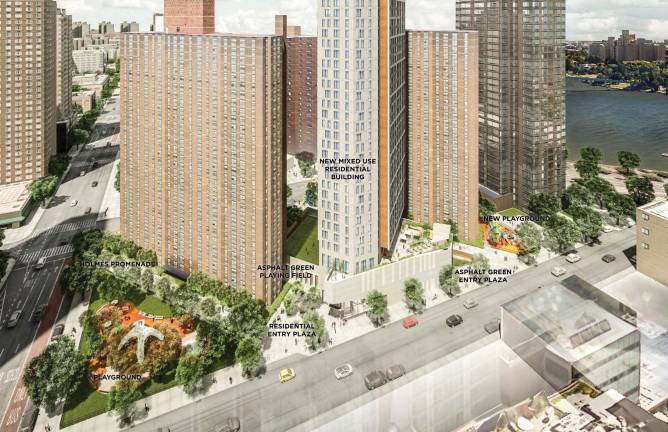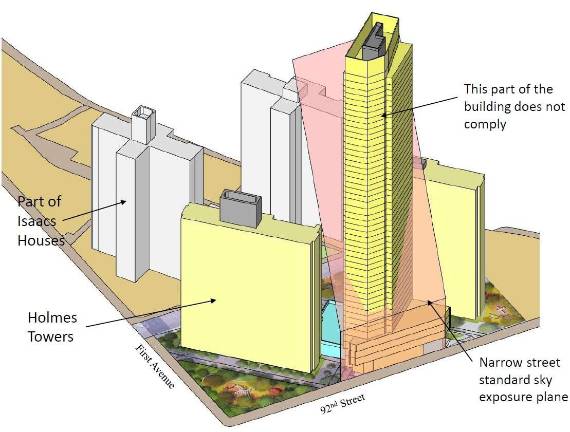By Michael Garofalo
The city’s plan to allow a private developer to build a 500-foot tower on the campus of a Yorkville public housing development, which sparked backlash from neighbors and local elected officials upon its announcement last year, is facing continued opposition from many members of the Upper East Side’s Community Board 8, which met Nov. 28 to discuss and gather more information on the project.
In May 2017, the city announced that Fetner Properties would pay $25 million to the beleaguered New York City Housing Authority for the privilege of building a 50-story residential building on the grounds of NYCHA’s Holmes Towers development at East 92nd Street and First Avenue. The new building, which will sit directly between the two existing 25-story Holmes Towers buildings and replace a playground, will include approximately 339 residential units, 169 of which will be publicly subsidized affordable housing.
The Fetner project is part of a broader city initiative, known as NextGeneration NYCHA, to raise revenue for the underfunded housing authority by allowing so-called “infill” development by private builders on open space in public housing developments. NYCHA says that the money it raises through these developments—including the $25 million Fetner will pay for its 99-year lease of the Holmes Towers site — will help to offset the agency’s vast capital needs and fund maintenance and repairs in NYCHA buildings, many of which have experienced chronic heat, hot water and elevator outages in recent years amid management crises and federal budget cuts.
Critics of the Fetner deal claim that the city failed to negotiate adequate compensation from the developer, and say that the revenue generated by the new building won’t do enough to address NYCHA’s nearly $32 billion in capital needs. The $25 million NYCHA will receive from Fetner is well short of Holmes Towers’ five-year capital needs of nearly $59 million.
“It surprises me that New York City was only able to negotiate $25 million from a developer who stands to make hundreds of millions on this property,” said Ben Kallos, who represents Yorkville in the City Council. “This deal is too good to be true if you are the developer; we can do better for the residents.”
NYCHA has said that Fetner Properties was selected to develop the site in part due to its proposal’s inclusion of community amenities, including a $13 million facility in the building’s base which will be operated by Asphalt Green and feature a rooftop athletic field and an indoor basketball court. Fetner also committed to hire at least eight Holmes Towers residents to fill permanent jobs created by the new development.
Kallos and others have said that any new housing at the site should be entirely affordable rather than the 50 percent included in the Fetner deal.
The new building’s 169 affordable units will be reserved for residents earning between 30 and 60 percent of the New York City region’s area median income, or AMI.
The majority of units, 60 percent, will be reserved for individuals or families earning up to 60 percent of AMI, which as of this year is $43,860 for an individual and $62,580 for a family of four. Of the remaining units, 15 percent will be allocated to residents earning up to 50 percent of AMI, 15 percent will be allocated to residents earning up to 40 percent of AMI and 10 percent will be allocated to residents earning up to 30 percent of AMI, which is $21,930 for an individual and $31,290 for a family of four.
Hal Fetner, the development company’s president and CEO, said in an interview that all 169 affordable units will remain affordable for the duration of Fetner’s 99-year lease and that every residential floor will feature at least one affordable unit. Market-rate and affordable residents will use the same entrance; the building will not have a “poor door,” as some other mixed-income housing developments in the city have utilized. Every unit in the building, affordable and market-rate alike, will feature the same floors, appliances and other finishes, Fetner said.
Fetner added that a 100 percent affordable development would fail to generate new revenue for NYCHA buildings and would cost taxpayers more in housing subsidies. “We really do care about creating affordable housing and creating revenue to make sure that the residents can live in clean, safe housing,” Fetner said. “We as a community need to find ways to make sure that these buildings don’t fall into further deterioration.”
Fetner and his wife, Nina, each made campaign contributions of $4,950, the maximum allowed by law, to Mayor Bill de Blasio’s reelection fund in 2017.
At a Nov. 8 meeting of Community Board 8’s committees on housing, zoning and development, and health, seniors and social services, attendees also discussed zoning questions raised by the Holmes Towers plan.
According to George Janes, a planning consultant who has analyzed the proposal and briefed the community board on his findings, the proposed Fetner building would not adhere to local zoning requirements. Specifically, he said, the building would grossly exceed the district’s sky exposure plane, which requires tall buildings to be set back from the street to preserve light and air at street level.
Janes believes the de Blasio administration is likely to utilize a mechanism known as a mayoral zoning override to waive the height and setback requirements and allow the project to move forward. The override would effectively preclude the community board, borough president and City Council from having formal input on the process.
Community Board 8 members at the meeting proposed a resolution expressing the board’s opposition to the use of a mayoral zoning override on the project; the full board is expected to vote on the resolution at its Dec. 19 meeting.
“To take away the amenity of light and air from the residents of the existing buildings to make way for a 50-story building that doesn’t comply with Zoning Resolution is a problem, and it isn’t fair to those NYCHA residents,” Alida Camp, the chair of Community Board 8, said.
Spokespeople with the mayor’s office and NYCHA would not address the zoning issues at play or the possible use of a mayoral zoning override despite repeated inquiries. But the city acknowledged the override as a possibility in an August 2018 federal filing, writing, “It is anticipated that a waiver may be sought for some items including penetration of the sky exposure plane.”
Damon Pazzaglini, Fetner’s COO, said one of the goals of the building’s design is to minimize impact to the existing buildings, and that a waiver would help to make this possible. “If we had to comply with height and setback [restrictions], we would have to put the building in the middle of NYCHA’s campus, which would be far more disruptive to the residents of Issacs [Houses, a neighboring public housing development] and Holmes,” he said.
Representatives of the mayor’s office, NYCHA and Fetner did not attend the Nov. 28 meeting but are expected to present an update to Community Board 8 in January.

